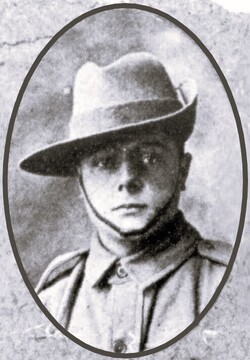
13209
GILBERT, James Henry
| Service Number: | 3119 |
|---|---|
| Enlisted: | Not yet discovered |
| Last Rank: | Private |
| Last Unit: | 27th Infantry Battalion |
| Born: | Shepherd's Bush, Middlesex, England, 16 March 1898 |
| Home Town: | Norwood (SA), South Australia |
| Schooling: | - |
| Occupation: | Labourer |
| Died: | Natural causes, Adelaide, South Australia, Australia, 15 July 1980, aged 82 years |
| Cemetery: |
Dudley Park Cemetery, South Australia |
| Memorials: |
World War 1 Service
| 12 Jan 1916: | Involvement Private, 3119, 27th Infantry Battalion, --- :embarkation_roll: roll_number: '15' embarkation_place: Adelaide embarkation_ship: HMAT Medic embarkation_ship_number: A7 public_note: '' | |
|---|---|---|
| 12 Jan 1916: | Embarked Private, 3119, 27th Infantry Battalion, HMAT Medic, Adelaide | |
| 25 Apr 1917: | Wounded AIF WW1, Private, 3119, 27th Infantry Battalion, GSW abdomen | |
| 27 Dec 1917: | Discharged AIF WW1, Private, 3119, 27th Infantry Battalion, Medically unfit | |
| Date unknown: | Wounded 3119, 27th Infantry Battalion |
Help us honour James Henry Gilbert's service by contributing information, stories, and images so that they can be preserved for future generations.
Add my storyBiography contributed by Tanase Elina
GILBERT, James Henry
Private James Henry Gilbert (service number 3119), was a British migrant who moved from Shepherds Bush, London to Norwood, South Australia. He was born in 1894 and enlisted in World War One on August 3rd, 1915 at the age of 18 years and 4 months and was assigned to the 7th Reinforcement of the 27th Battalion. He was 159cm tall at the time of enlisting and weighed 54kg. He had dark brown hair, brown eyes and was of a medium complexion. Before enlisting in the war, James was a labourer.
His father, Thomas Gilbert also served in World War 1 in the 11th Light Horse Regiment.. He fought in the Infantry Trench warfare and frontline battles. James was in Belgium, France, Merseilles and Rouen (hospital). Whilst all these battles were going ahead, the places he had fought or had been taken to were being invaded by Germany.
James carried a rifle, bayonet and hand grenades. Grenades were more practical as they could be easily carried by foot soldiers and were a very efficient weapon, destroying larger groups of opposing soldiers at one time. The rifle was a reasonably large weapon, heavy and difficult to carry but it was efficient. Bayonets were usually attached on the rifle for use in close combat.
His Battalion was nicknamed “Dollman’s Dinkum Dugout Diggers.” The 7th Brigade joined the New Zealand Australian division and James was sent to France on August 11th, 1916. He became sick a short time later with Pyrexia (high fever and compromised immune system) and was admitted to a military hospital in Belgium on the 25th of September 1916. On the 10th of October he re-joined the battalion and was immediately deployed back into the field. Again, he was overcome by sickness and was admitted to a field hospital on the 2nd of November suffering from influenza (respiratory infection). His recovery was prompt and he was back with the battalion on the 10th of November, 1916. During the time of his recovery in hospital his mother, Charlotte Phoebe Gilbert died.
Private James Gilbert’s battalion was deployed to Montauban on the 24th of December, 1916 where he joined the Melbourne Camp. His battalion was accommodated in Mission Huts. War diary entries by his commanding officer described almost impassable mud everywhere, bitterly cold winds, and wet weather. On Christmas day of that year his commanding officer noted that, “Christmas Cheer was conspicuous by its absence” (27th Battalion 23/44/16). Conditions of battle were harsh and great difficulty was experienced in preventing trench feet.
Private James Henry Gilbert remained relatively injury and sickness free until he was severely injured in battle in Bapaume, France on the 25th of April 1917. His battalion had been deployed there on the 14th of April, diary entries of the time describe several days of heavy shelling, and Bangalore torpedo attacks including April 21st, April 23rd and April 26th. Due to the severity of his wounds, Private James Henry Gilbert was transferred back to England. He boarded the H.S Pieter de Conick on the 17th of May, 1917 in Boulogne to return to England where he was immediately admitted to the Taplow Canadian Red Cross hospital for treatment to a gunshot wound to his abdomen and groin.
After several months of hospitalization, he returned to Australia on the 19th of October, 1917 and was formally discharged from service by the Keswick Barracks, Adelaide on the 27th of December, 1917 on the grounds of being medically unfit for service. His total time of war service was two year and one hundred and forty-seven days. His total war service abroad was one year and three hundred and thirty-five days.
BIBLIOGRAPHY –
SERVICE RECORD – PRIMARY
National Archives of Australia n.d., NAA: B2455, GILBERT J H, Australian Government, accessed 8 March 2017,
UNIT DIARY - PRIMARY
Australian War Memorial n.d., AWM4 Subclass 23/44 - 27th Infantry Battalion, Australian Government, Canberra, accessed 8 March 2017,
WEAPONRY (BAYONETS) - SECONDARY
Duffy, M 2009, Weapons of War - Bayonets, accessed 8 March 2017,
WEAPONRY (GRENADES) – SECONDARY
Duffy, M 2009, Weapons of War - Grenades, accessed 8 March 2017,
AUSTRALIAN WAR MEMORIAL – SECONDARY
Australian War Memorial n.d., Dawn of the Legend, accessed 8 March 2017,
WHAT WAS GOING ON DURING WORLD WAR ONE? – SECONDARY
BBC 2016, What happened during World War One?, BBC, Britain, accessed 8 March 2017,













